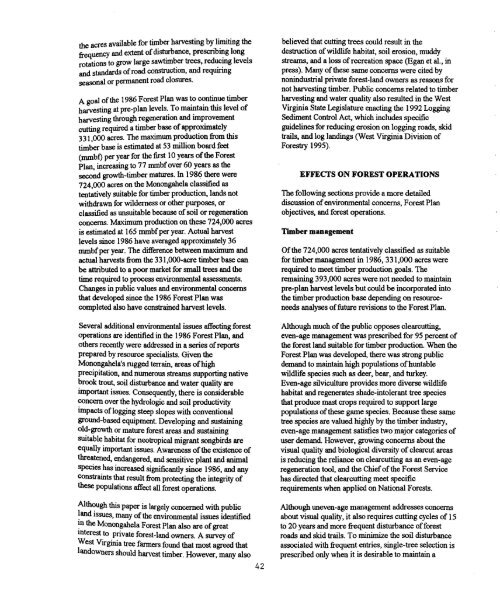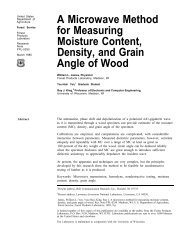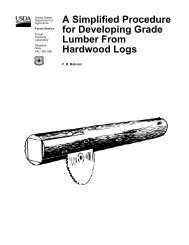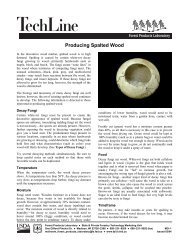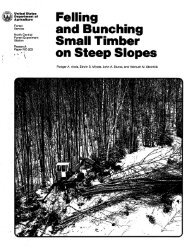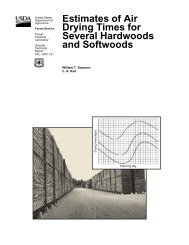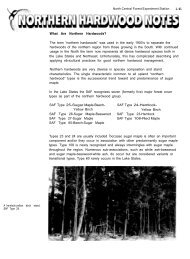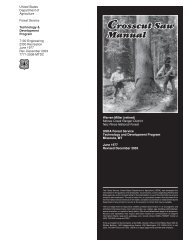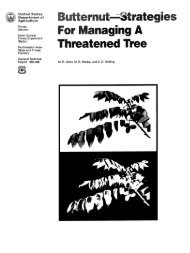Planning and implementing forest operations to achieve ... - Woodweb
Planning and implementing forest operations to achieve ... - Woodweb
Planning and implementing forest operations to achieve ... - Woodweb
Create successful ePaper yourself
Turn your PDF publications into a flip-book with our unique Google optimized e-Paper software.
theacresavailable fortimberharvesting by limiting the<br />
frequency <strong>and</strong>exten<strong>to</strong>fdisturbance, prescribing long<br />
rotations <strong>to</strong>growlargesawtimbertrees, reducinglevels<br />
<strong>and</strong>st<strong>and</strong>ards ofroadconstruction, <strong>and</strong>requiring<br />
seasonal orpermanentroadclosures,<br />
believedthatcutting treescouldresultinthe<br />
destruction ofwildlife habitat, soilerosion, muddy<br />
streams, <strong>and</strong>a lossofrecreation space(Eganetal.,in<br />
press). Many ofthesesameconcernswere citedby<br />
nonindustrial private <strong>forest</strong>-l<strong>and</strong> ownersasreasonsfor<br />
notharvesting timber.Publiconcernsrelated <strong>to</strong>timber<br />
A goalofthe1986ForestPlanwas<strong>to</strong>continue timber harvesting <strong>and</strong>waterquality alsoresulted intheWest<br />
harvesting atprc-plan levels. To maintainthislevelof Virginia StateLegislature enacting the1992Logging<br />
harvesting throughregeneration <strong>and</strong>improvement<br />
SedimentControlAct,whichincludes specific<br />
cutting required atimberbaseofapproximately<br />
guidelines forreducingerosionon loggingroads,skid<br />
331,000 acres. The maximum production from this trails, <strong>and</strong> log l<strong>and</strong>ings (West Virginia Division of<br />
timber base is estimated at 53 million board feet Forestry 1995).<br />
(mmbf) per year for the first 10 years of the Forest<br />
Plan, increasing <strong>to</strong> 77 mmbf over 60 years as the<br />
second growth-timber matures. In 1986 there were EFFECTS ON FOREST OPERATIONS<br />
724,000acreson theMonongahelaclassified as<br />
tentatively suitable fortimberproduction, l<strong>and</strong>snot<br />
Thefollowing sections provideamore detailed<br />
withdrawnforwilderness orotherpurposes,or<br />
discussion ofenvironmental concerns, ForestPlan<br />
classified asunsuitable becauseofsoilorregeneration objectives, <strong>and</strong><strong>forest</strong><strong>operations</strong>.<br />
concerns. Maximum productionon these724,000acres<br />
is estimated at 165 mmbfper year. Actual harvest<br />
Timber management<br />
levels since 1986 have averaged approximately 36<br />
mmbf peryear.The difference betweenmaximum <strong>and</strong> Of the724,000acrestentatively classified assuitable<br />
actualharvests fromthe331,000-acre timberbasecan fortimbermanagementin1986,331,000acreswere<br />
be attributed <strong>to</strong>apoormarketforsmalltrees<strong>and</strong>the required <strong>to</strong>meettimberproduction goals.The<br />
timerequired <strong>to</strong>processenvironmental assessments, remaining393,000acreswerenotneeded<strong>to</strong>maintain<br />
Changesinpublicvalues<strong>and</strong>environmental concerns pre-planharvestlevelsbutcouldbe incorporated in<strong>to</strong><br />
that developed since the 1986 Forest Plan was<br />
the timber production base depending on resourcecompleted<br />
also have constrained harvest levels,<br />
needs analyses of future revisions <strong>to</strong> the Forest Plan.<br />
Several additional environmental issues affecting <strong>forest</strong> Although much of the public opposes clearcutting,<br />
<strong>operations</strong> are identified in the 1986 Forest Plan, <strong>and</strong><br />
even-age management was prescribed for 95 percent of<br />
others recently were addressed in a series of reports<br />
the <strong>forest</strong> l<strong>and</strong> suitable for timber production. When the<br />
prepared by resource specialists. Given the<br />
Forest Plan was developed, there was strong public<br />
Monongahela's rugged terrain, areas of high<br />
dem<strong>and</strong> <strong>to</strong> maintain high populations of huntable<br />
precipitation, <strong>and</strong> numerous streams supporting native wildlife species such as deer, bear, <strong>and</strong> turkey.<br />
brook trout, soil disturbance <strong>and</strong> water quality are<br />
Even-age silviculture provides more diverse wildlife<br />
important issues. Consequently, there is considerable habitat <strong>and</strong> regenerates shade-in<strong>to</strong>lerant tree species<br />
concern over the hydrologic <strong>and</strong> soil productivity<br />
that produce mast crops required <strong>to</strong> support large<br />
impacts of logging steep slopes with conventional<br />
populations of these game species. Because these same<br />
ground-based equipment. Developing <strong>and</strong> sustaining<br />
tree species are valued highly by the timber industry,<br />
old-growth or mature <strong>forest</strong> areas <strong>and</strong> sustaining<br />
even-age management satisfies two major categories of<br />
suitable habitat for neotropical migrant songbirds are<br />
user dem<strong>and</strong>. However, growing concerns about the<br />
equally important issues. Awareness of the existence of visual quality <strong>and</strong> biological diversity of clearcut areas<br />
threatened, endangered, <strong>and</strong> sensitive plant <strong>and</strong> animal is reducing the reliance on elearcutting as an even-age<br />
species has increased significantly since 1986, <strong>and</strong> any regeneration <strong>to</strong>ol, <strong>and</strong> the Chief of the Forest Service<br />
constraints that result from protecting the integrity of<br />
has directed that clearcutting meet specific<br />
these populations affect all <strong>forest</strong> <strong>operations</strong>, requirements when applied on National Forests.<br />
Although this paper is largely concerned with public<br />
Although uneven-age management addresses concerns<br />
l<strong>and</strong> issues, many of the environmental issues identified about visual quality, it also requires cutting cycles of 15<br />
in the Monongahela Forest Plan also are of great<br />
<strong>to</strong> 20 years <strong>and</strong> more frequent disturbance of <strong>forest</strong><br />
interest <strong>to</strong> private <strong>forest</strong>-l<strong>and</strong> owners. A survey of<br />
roads <strong>and</strong> skid trails. To minimize the soil disturbance<br />
West Virginia tree farmers found that most agreed that associated with frequent entries, single-tree selection is<br />
l<strong>and</strong>owners should harvest timber. However, many also prescribed only when it is desirable <strong>to</strong> maintain a<br />
42


